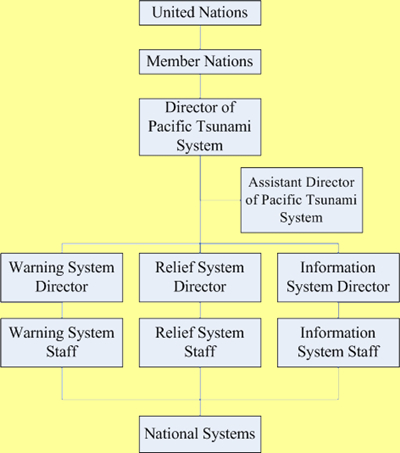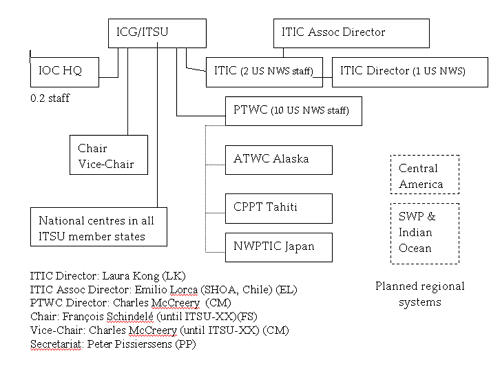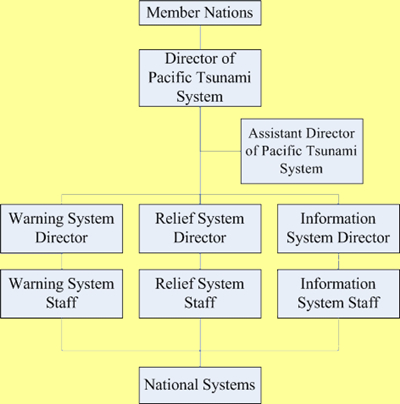

| Tsunami10 is pursuing two methods of organization for the overall system. The first is solely Peru and Micronesia. The second involves upgrading the overall warning system in place in the Pacific Ocean. |
| Warning System |
| Other Recommendations for a Pacific System |
| Relief |
|
In this instance, Peru and Micronesia would create tsunami warning systems independent of the current Pacific warning system. Tsunami10 has decided with the other groups that this plan is not the best solution, but we are continuing to develop it as an option for Mission. All of the administration, warning system, education, and response would fall on the governments themselves as do the current national systems.1 Initial supplies may be provided from the international community for local food depots. In the event of a tsunami, the depots would provide materials to last until international aid could come. Afterwards, the depots would be resupplied by the international community. Also, each nation would be responsible for the handling of non-governmental organizations (NGO's). However, both nations would be partnered with another entity to assist them. NGO's helping Micronesia would go through the United States due to the dependence of Micronesia on America.2 Peru would be assisted by the United Nations because this would aggravate the international community the least while allowing order to be maintained. |
|
The other option is upgrading the current Pacific Tsunami warning system. Tsunami10 is developing two plans along these lines. The first involves the new system being a part of the UN in oversight only. The system would be administered by the nations who signed the treaty bringing it into effect. The system would resemble:
This option has key advantages over an independent network. One entity would warn everyone who would be potentially harmed by an event, ensuring proper communication. It would also provide for more efficient use and distribution of supplies.3 A central organization would transfer materials to where they would be needed and also maintain the supply depots. NGO's would also be more effectively regulated. The central relief organization would be able to coordinate NGO efforts, directing them to where they would be needed. Anyone wishing to provide support would need to go through the central relief agency. Being a part of the UN, the NGO's would most likely follow the organization's wishes. Such a plan also allows for the difference between the governments of Micronesia and Peru to be taken into account. Peru has a much more capable government and will therefore be able to take on responsibility. Micronesia doesn't have those same capabilities. This form of plan accounts for this by allowing Peru to have a stronger national system, which would default to the international system less often than Micronesia. In this way, both still receive the supplies and support that is necessary and are yet able to be as independent as possible. The inclusion of an overall relief system makes sense if one examines the recent Indian Ocean tsunami. The UN stepped in quickly afterward, making sure that nations had what they needed to control the situation through its numerous organizations.4 5 6 What both these plans would do would be to shift that reasonability onto a differing organization that has official control for all nations. It would also combine the efforts of the UN into one organization. In both systems, the new system would supplant other systems that are currently in place around the world. The chief of which would be the International Tsunami Information Center.7 This organization serves as a think tank for the world's tsunami experts and also serves to develop and implement new warning and prevention systems. Though this is part of the UN, the natural place for it would be in any new, comprehensive international system. Along with this, the ITIC's parent organization, the ICG/ITSU would be removed from the Intergovernmental Oceanographic Commission (IOC) and incorporated in the new system as well. The structure of the current system is:
Under any of these two systems, the systems in the Pacific Basin would be merged into one overall system. The leaders would be appointed by the member nations of the system and continue to represent all of the members of the system. If the system were to be created under the UN, these would be the only changes. If created under an independent treaty, the organization would be removed from the system. Integrating it into the Pacific system would change it's role slightly in the world. It could still serve as the forum for the world through a conference which would be held at least yearly where the nations would instruct the directors about the direction they would like to see the system go in over the next year. Directly prior to this, a conference would also be held where the world's intellectuals could weigh in on the system. Recommendations could then be viewed by the delegates and action can then be ordered on them. The new structure could still advocate on behalf of new systems worldwide, possibly creating one world system for tsunami warning later in the future. The other option tsunami10 is pursuing is the creation of two independent organizations which would control the system and the relief if a tsunami occurred, basically the same as above but outside of the UN. The chief reason for this is the possibility of bureaucracy in the UN preventing the system from performing to its potential. However, it shares many of the benefits of the previous plan. NGO's may not recognize the authority of the central relief agency without the countries mandating after an event that they follow the developed plan. Until more information is gathered from Mission 2009 on the whole, tsunami10 will continue to present both plans.
|
|
Independent Systems If the systems remained independent, it would be the responsibility of Peru and Micronesia to warn their own populations. It would also be expected that they would pass the alarm on to neighboring countries and to the PTWC. The nations would also need to provide for specialists to monitor data and determine whether or not to call for an evacuation. International Systems In the case of international systems, the current warning system would be completely redone.8 For nations like Peru and Micronesia, nations which will have the ability to generate a quick alert, the initial alert will be sounded when the first buoys trip along its coast. This signal would then be passed on to national authorities as well as to the international warning station. The international station would determine whether the buoy was correct. If it was correct, the center would go into a full scale activation. It would confirm the warning in the nations with the quick response by switching on its warning system for that nation. Then it would call the authorities as a backup policy to make sure that the message went through. While this is happening, the warning would spread from the international center to the areas who are going to affected first through the triggering of the warning system and the confirmation call. |
Other Recommendations for a Pacific System Integration of CTBTO Sensors into the Tsunami Seismic Network Currently the Comprehensive Test Ban Treaty Organization has seismic detectors stationed around the world to monitor for nuclear detinations.9 These could also monitor for seismic activity where there are currently few sensors. Furthermore, these sensors which are already in place could be useful in cutting down some of the costs for creating a system. Though they are only capable of gathering seismic data, they could still fill part of the gap until a system is fully installed. This would also be naturally extended to include all seismic sensors that are not currently wired into the tsunami system that are oceanic. |
Relief In any of the proposals, the first international aid would begin arriving within a day and a half of any incident.10 11 12 The immediate supplies that would arrive would be food and water. Once they arrive in the nation were they are needed, either that country's military or that of another nation would be in charge of distributing the supplies. Militaries have the tools, namely helicopters and boats, needed to distribute the supplies as well as a command structure that would remain intact after an incident. Calls for basic aid would go out as soon as a tsunami struck; this would allow for a quick response to needs. Needs such as water and food will be provided by the international community until the local areas can repair their infrastructure and begin to provide for themselves. Medical help would also be needed after a tsunami. Those that would be on the scene first would be the military and UN organizations, as seen during the Indian Ocean tsunami.13 Medical help approximately follows the same trend as other aid, with the first of it being available a day and a half after the incident. Peru would be able to respond more quickly due to the fact that transportation is less of an issue on land. India, during the Indian ocean tsunami, responded with aid in a day of the event.14 After the initial response, medical aid would come from the UN (the WHO and other departments) and also NGO's (organizations like the Red Cross and Doctors Without Borders15) until the medical infrastructure would be rebuilt. In an independent system, the national governments would work with the UN to find the supplies and distribution systems that it needed. In the UN international system, the pacific relief agency would be the one working with the affected governments to make sure that they had the supplies and network which they needed. The independent international system would have the relief agency working with the UN and the national governments to direct supplies and resources. |










